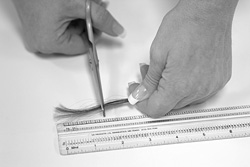Your cart is currently empty
The Core Care Center partners Analytical Research Labs, Inc. in Phoenix, Arizona for hair analysis. When you order a test, we will send you a kit that includes all you need to submit a sample. We will cover the results and any corrective actions needed.

Providing a mineral blueprint of one's biochemistry, a hair tissue mineral analysis can provide pertinent information about one's metabolic rate, energy levels, and stage of stress.
A hair tissue mineral analysis performed by Analytical Research Labs, Inc., is a screening test for the level of 20 minerals and toxic metals in a sample of hair. It is a tissue mineral biopsy that is non-invasive, relatively inexpensive and extremely accurate. Our laboratory uses only the most advanced and sophisticated instrumentation available today, the Perkin Elmer ICP-MS nexION 2000B Mass Spectrometer to assess mineral levels in parts per million or parts per billion.
A hair tissue mineral analysis is considered a standard test used around the world for the biological monitoring of trace elements and toxic metals in humans and animals species. The same technology is used for soil testing and testing of rock samples to detect mineral levels.
Hair, like all other body tissues, contains minerals that are deposited as the hair grows. Although the hair is dead, the minerals remain as the hair continues to grow out. A sample of hair cut close to the scalp provides information about the mineral activity in the hair that took place over the past three to four months, depending on the rate of hair growth.
A hair tissue mineral analysis (HTMA) simply stated, is a screening test that measures the mineral content of your hair. However, a hair tissue mineral analysis is much more than a test for minerals. Providing a blueprint of one's biochemistry, a hair tissue mineral analysis can provide pertinent information about your metabolic rate, energy levels, carbohydrate tolerance, stage of stress, immune system and glandular activity. This screening test can also be used to reduce the guesswork involved when recommending nutritional supplements and dietary modifications.
Blood tests and urine tests obviously provide important information about a person's biochemical status, but they only evaluate the fluids in the body. However, the vast majority of biochemical functions actually take place inside the cells themselves. Of course, we can't conveniently take snips out of the various organs of a person's body in order to evaluate what is going on in the cells, but there are cells conveniently available to us, the cells of the hair. Through extensive research and correlation of data, it has been established that there are reliable relationships between the levels of minerals in the hair and other tissues of the body. Thus, analysis of the mineral content of an individual's hair can provide us with a general 'blueprint' of the mineral content in the rest of the body's tissues. Since these minerals are crucial to the functioning of enzymes, hormones and other biochemical systems which sustain life, it is possible to read this 'blueprint' and see where metabolic patterns are deviating from normal.
Another benefit of hair analysis is that it may be used to assist the health care professional to pinpoint the development of metabolic dysfunctions often before symptoms manifest. While mineral imbalances in the body do eventually show up in the blood serum, they will not do so until the condition is so advanced that the individual is often experiencing overt symptoms. Tissue mineral analysis allows us to determine that an imbalance exists, before the imbalance begins to manifest disturbances on a symptomatic level. Therefore, the imbalance can often be corrected through nutritional therapy even before a person begins to suffer from metabolic symptoms.
Mineral levels and ratios as determined by Analytical Research Labs for each individual are measured against an 'ideal' standard of health, rather than an 'average' standard as used by other laboratories. This renders our results more sensitive and meaningful to those people who aspire to optimum levels of health.
We work with precise mineral levels and ratios rather than with the broad ranges employed by the majority of professionals engaged in hair analysis. As a result, we identify even slight deviations from 'ideal' values responsible for some disorders which would escape detection by other labs.
Our tests recognize biochemical individuality through determination of three basic oxidation types, thus providing a sound basis for an accurate and specific selection of nutrients based on the individual's metabolism. Detrimental health effects arising from mismatching of nutrients with individual metabolism are therefore avoided.
We currently require a minimum of 125 mgs of hair to complete the entire mineral assay.
The accuracy and reliability of the test results and interpretation is based upon the laboratory receiving a properly collected hair sample that is clean and free from external contaminants. The ideal hair sample should be collected prior to subjecting the hair to any treatments such as bleaching, permanents, or dyes. This also includes the application of hair sprays, hair creams, gels and oils. Additionally, the hair should be washed within 24 hours of sampling and must be dry for at least 4 hours after shampooing.

There are several cautions and concerns regarding hair products. Most shampoos, rinses and conditioners do not contain metals and will not effect the accuracy of the analysis. However, medicated shampoos of concern are Selsun Blue(selenium) and Head and Shoulders(zinc). Grecian Formula contains lead and iron.
The hair sample should be cut as close to the scalp as possible and should be a maximum of 1.5 inches in length. The distal end of the hair longer than 1.5 inches should be discarded.

The recommended location for collection would be the nape of the neck.
It is very important to place the hair sample in the sampling envelope provided before sending to the laboratory. Do not place hair samples in plastic baggies or aluminum foil. Do not tape or staple the hair sample to the scale or sampling envelope.
Do not mix different types of hair such as head hair with pubic hair or beard hair in the same sampling envelope. We strongly recommend using head hair only due to it's consistent rate of growth. Pubic and other body hair should only be used if sufficient head hair is not available.